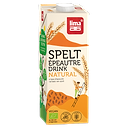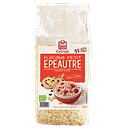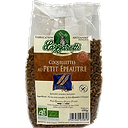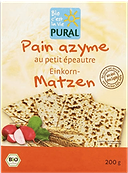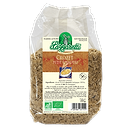In an era where our diet is often too refined, too processed, and sometimes lacking nutrients, many people are seeking to return to whole, healthy, and digestible foods. Among them, small spelt deserves to be better known. This ancient rustic grain, rich in fiber and protein and easier to digest than wheat, is an ideal alternative to diversify your diet while providing essential nutrients to the body.
A Millennia-Old Cereal at the Heart of Our Regions
Small spelt, also called "einkorn," is one of the oldest cereals cultivated by humans, long before common wheat. Evidence of its cultivation can be found in the Fertile Crescent more than 10,000 years ago. Later introduced to Europe, it has long been grown in mountainous areas, notably in Provence, where it is still produced today using traditional farming methods.
What makes small spelt unique is that it has not undergone the genetic modifications that other modern varieties have experienced. The result is a whole grain, dense and naturally rich cereal, with low gluten content and much easier to digest than its industrial relatives.
A Remarkable Nutritional Composition
Small spelt deserves a place on your plate not only for its history but also for its nutritional richness. It contains all eight essential amino acids, a rarity in the plant kingdom. Its protein content is significant, around 12 to 15%, making it a good ally for vegetarian or flexitarian diets.
Moreover, its high dietary fiber content makes it a great food choice to support good digestion, promote satiety, and help balance blood sugar levels. Whole small spelt grains are also a good source of minerals such as magnesium, zinc, and iron, which are essential for nervous system and immune health.
Finally, with its low gluten content, this ancient cereal is often better tolerated by sensitive individuals, although it is not suitable for people with celiac disease.
How to Incorporate Small Spelt into Your Cooking?
Small spelt comes in various forms, making it easy to incorporate into different recipes. Whether as grains, pasta, bread, or flour, the possibilities are numerous.
As Grains
Small spelt grains are cooked similarly to brown rice. After rinsing and ideally soaking, cooking takes about 45 minutes in twice their volume of water. This method preserves the maximum nutrients while ensuring good digestibility. It can be served hot with vegetables or cold in a salad for a complete dish rich in fiber and protein.
As Bread
Small spelt bread is an excellent alternative to traditional bread. Thanks to its naturally richer and more aromatic flour, it has a dense texture, a slightly sweet taste, and better digestibility. It can be made using 100% small spelt flour or mixed with other flours such as buckwheat or oat flour.
As Flour
Small spelt flour is ideal for baking: crepes, cookies, cakes, or pie crusts. It offers a pleasant texture and unique flavor while maintaining high nutritional value. Its low rising capacity (due to reduced gluten content) can be compensated by adding leavening agents or mixing with other more bread-friendly flours.
As Pasta
Small spelt pasta is becoming increasingly popular. It is easy to cook, has a pleasant texture, and a rustic taste. It offers a great alternative to classic wheat pasta, with higher protein and fiber content and often fewer additives or added salt.
Why Choose Small Spelt?
Choosing small spelt means opting for a more authentic product, more environmentally friendly, and better suited to our physiology. It fits perfectly into a healthy diet, whether for its nutritional properties, low gluten content, or sustainable farming methods. It is also a matter of taste: its slightly sweet flavor, tender texture when cooked, and versatility in many recipes make it a basic ingredient worth rediscovering.
In conclusion, small spelt is much more than a trend: it’s a return to the roots, to a more complete, digestible, and balanced diet. Whether you choose it as bread, pasta, grains, or flour, it will enrich your meals while respecting your health.
Want to give it a try?
FAQ – Small Spelt: Your Most Frequently Asked Questions
1. Is small spelt gluten-free? No, but its gluten content is much lower than that of wheat, making it easier to digest for some people.
2. Can it be used in homemade bread recipes? Absolutely. Small spelt bread has a dense crumb and a very aromatic flavor.
3. What is the difference between small and large spelt? Small spelt is older, more digestible, and richer in nutrients. It has not been crossbred with other species like large spelt.
4. Can you buy organic small spelt? Yes, it’s quite common. This rustic cereal is very well suited to organic farming.
5. Is it a good source of protein? Yes, it contains all essential amino acids and a good amount of plant protein.
6. Is the cooking time long? About 45 minutes for the grains, but it can be reduced if the grains are soaked beforehand.
7. Is it suitable for children? Yes, especially as flour or bread, to diversify daily cereal products.
8. What pairs well with small spelt? It goes very well with seasonal vegetables, seeds, or legumes like fava beans.
9. Is it low in fat? Like all cereals, yes. Its fiber content also helps moderate saturated fat absorption in a meal.
10. Where to find small spelt? At Kazidomi, of course! We offer a selection of small spelt products: flour, grains, pasta, and ready-to-cook mixes. Check it out here.


